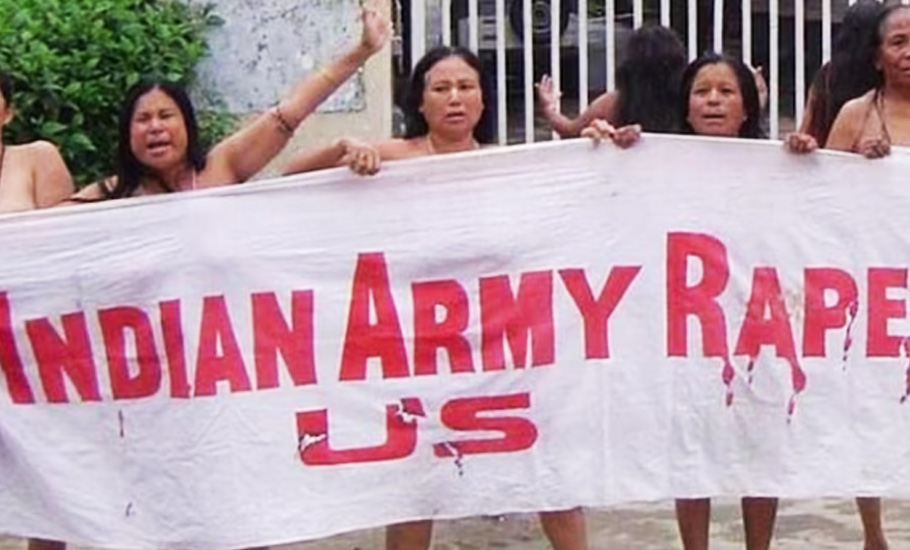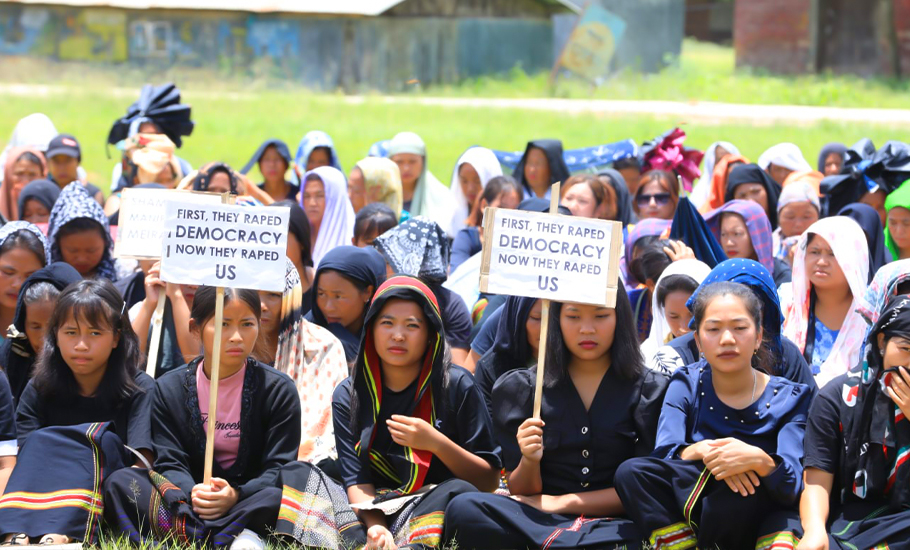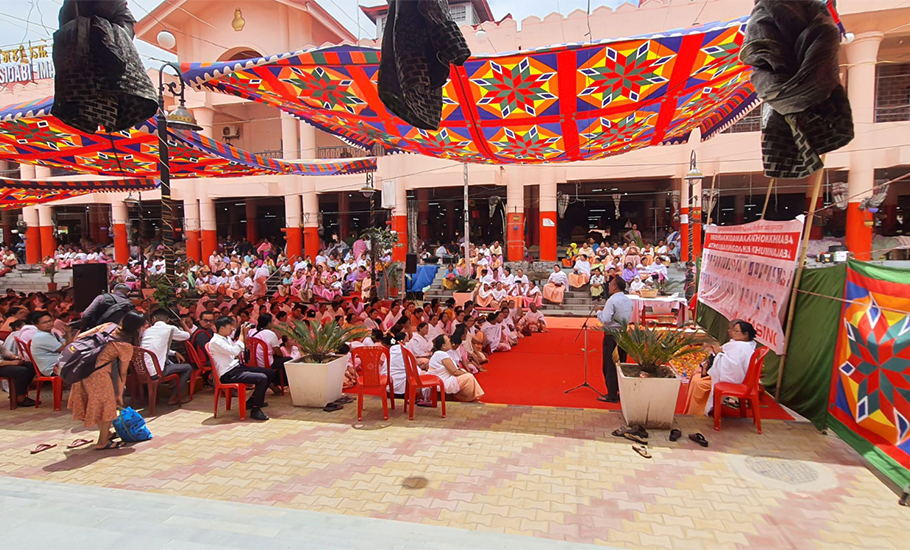
- Home
- News
- Analysis
- States
- Perspective
- Videos
- Education
- Entertainment
- Elections
- World Cup 2023
- Features
- Health
- Business
- Series
- Economy Series
- Earth Day
- Kashmir’s Frozen Turbulence
- India@75
- The legend of Ramjanmabhoomi
- Liberalisation@30
- How to tame a dragon
- Celebrating biodiversity
- Farm Matters
- 50 days of solitude
- Bringing Migrants Home
- Budget 2020
- Jharkhand Votes
- The Federal Investigates
- The Federal Impact
- Vanishing Sand
- Gandhi @ 150
- Andhra Today
- Field report
- Operation Gulmarg
- Pandemic @1 Mn in India
- The Federal Year-End
- The Zero Year
- Premium
- Science
- Brand studio
- Home
- NewsNews
- Analysis
- StatesStates
- PerspectivePerspective
- VideosVideos
- Entertainment
- ElectionsElections
- Sports
- Loading...
Sports - Features
- BusinessBusiness
- Premium
- Loading...
Premium

How Manipur came to weaponise women’s bodies in the Kuki-Meitei violence

On July 15, 2004, 12 women — the oldest 73 and the youngest 45 — descended at the Assam Rifles headquarters outside the iconic Kangla Fort. Behind a white banner that read, “Indian Army rape us”, the women stood completely disrobed. The women, all housewives and hailing mostly poor families, were carrying out the ‘naked protest’ against the rape and murder of a 32-year-old...
On July 15, 2004, 12 women — the oldest 73 and the youngest 45 — descended at the Assam Rifles headquarters outside the iconic Kangla Fort. Behind a white banner that read, “Indian Army rape us”, the women stood completely disrobed.
The women, all housewives and hailing mostly poor families, were carrying out the ‘naked protest’ against the rape and murder of a 32-year-old Meitei woman named Thangjam Manorama, found with 16 bullet wounds in her genitals, by the personnel of 17th Assam Rifles.
The protest jolted not just the nation out of its slumber but, in fact, sent ripples around the world. Cutting across regional, religious and caste divides, the country unanimously stood behind the 12 who disrobed their bodies to present the collective plight of Manipuri women.

“It made us very angry. It was not just Manorama who was raped. We all felt raped,” the women later told the media.
Cut to 2023, the video of two tribal Manipuri women being paraded naked and sexually assaulted by a mob along a village road has further deepened the existing divide between the Meiteis and Kukis and fanned simmering anger on both sides.

Ever since the 26-second brief video surfaced on July 19 — 76 days after the horrific incident took place on May 4 — tearing to pieces Manipur’s once exalted image, more stories of sexual atrocities and other forms of violence against women started tumbling out of the violence-torn state.
The Kuki Women Organisation for Human Rights in a memorandum to Prime Minister Narendra Modi listed around 10 such incidents. The media cell of Indigenous Tribal Leaders Forum (ITLF) came out with a booklet detailing 13 cases of abuse and violence Kuki women were allegedly subjected to between May 3 and July 6.
On the other hand, Manipur Chief Minister Biren Singh himself claimed in a television interview that hundreds of such incidents took place in the state during the conflict that has been raging for almost three months. He, however, did not give any details of either the incidents or the action initiated against the perpetrators of the cases.
Nganbi Lourengbam, who had led the protest of imas (mothers) at the Kangla Fort almost two decades ago, told The Federal that both Kuki and Meitei women have become victims of sexual abuse and violence.
The stories of horror unfolding on Manipur’s streets prove Nganbi right.
An 80-year-old woman Sorokhaibam Ibetombi, whose late husband was a freedom-fighter, was burnt alive after being locking inside her house at Serou village in Kakching district in the wee hours of May 28.
“I am shocked and pained by what is happening to women from both communities in this cycle of violence. It should be stopped. This is not our culture,” 72-year-old Lourengbam, better known as ima (mother) Nganbi, told The Federal.
Women’s bodies are used as weapons against the enemy group in almost all violent conflicts across the world. But so far communities in India’s Northeast had largely remained immune to the trend. They had been in fact were at the receiving end as was the case with Manorama.

Weaponisation of women’s bodies during conflicts among communities is rare, if not unprecedented, in the Northeast, which has endured several ethnic clashes and fratricidal feuds, pointed out former deputy director general of India’s Defence Intelligence Agency Major General (retired) Gaganjit Singh.
“During my long stint in the region, I never came across any incident of women’s modesty being dishonoured during clashes between communities. The society in general in the region had a high respect for women,” said Major General Singh, who had played a crucial role in persuading Kuki militant groups to sign suspension-of-operation (SoO) agreement with the army in 2005. This was followed by a tripartite agreement between the government of India, Manipur government and the Kuki National Organisation (KNO) in 2008. Today, the agreement is one of the bones of contention in the conflict with the state government and Meitei civil society groups, who are demanding that the Centre scrap it.
“Except for one incident of an Adivasi protester being stripped and chased by a mob in Guwahati in 2007, I cannot recall any woman being targeted in any sort of conflict in the region to take revenge on an entire community,” pointed out Dipankar Roy, editor-in-chief of The Meghalayan, a Shillong-based daily, who has been reporting on northeast for about four decades.
The army officer and the senior journalist, however, recalled that the United National Liberation Front (UNLF) and the Kangleipak Communist Party (KCP) — the two valley-based armed insurgent groups — were accused of mass rape at a Hmar village in Churachandpur district in 2006.
The two outfits had refuted the allegations and demanded an ‘independent’ probe by an entity like the International Red Cross. They say barring that incident even the armed insurgents by and large refrained from such barbarism.
“The recent incidents in Manipur call for a deeper study to find what went so wrong this time that the women are being targeted to defeat or humiliate the ‘other’ community,” the Major General said.
Social scientists and northeast observers argue that this deviation is largely attributable to the very nature of the present conflict that has led to total segregation of the two warring communities.
“The past conflicts were an outcome of social tension and not hatred. But this time there have been systematic efforts to radicalise and polarise the society through hatred,” said Walter Fernandes, the director of the Guwahati-based North Eastern Social Research Centre.
“What has been witnessed in Manipur is not a mere civil discord between two communities. Criminal and political elements have entered the conflict and genuine apolitical civil society groups have been sidelined,” he added.
The complete disdain and hatred towards the “other” community is unmistakable in the narratives being pushed by the conflicting parties. Even those in responsible positions are found to be promoting biases and prejudices with a clear intention to polarise.

Kukis have been for some time now been branded as narco terrorists and illegal migrants. On the other hand, a fear has been spread among the Kukis that Meiteis want to grab tribal land and resources by acquiring Scheduled Tribe (ST) status.
Pramot Singh, chief of a valley-based outfit Meitei Leepun, went to the extent of saying that the entire Kuki population from a particular area would be “wiped out” for blocking “essential commodities, and setting up encroachments”. He called members of the community as outsiders.
The government apparatus has encouraged such hate speech and dogwhistling by either not acting or delaying action. For instance, the Manipur Police registered a criminal case against Singh for promoting enmity between communities almost a month after he made the comment. Singh, a former Akhil Bharatiya Vidyarthi Parishad member, described himself in his Facebook status as a “decent looking criminal”.
Social media is awash with similar vitriolic and xenophobic content, acting as a force multiplier in spreading hate.
“Fake news and false narratives are being constantly peddled to vilify the other community to stir up hate. As a result, we are unprecedented parochialism that was never seen before,” said Prasanjit Biswas, a professor in North Eastern Hill University (NEHU).
Driven by hate, even common civilians are not hesitating in defying traditional norms and values to commit crimes that have no parallels in the history of protracted ethnic conflicts either in Manipur in particular, or the Northeast in general, he added.

